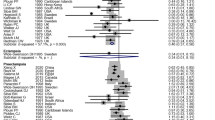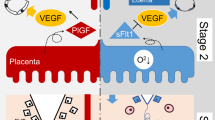Abstract
We investigated the trends in the proportion of antihypertensive prescriptions listed in the guidelines for pregnant patients and their pregnancy outcomes before and after regulatory actions in Japan. This retrospective cohort study used the Japan Medical Data Center claims data from January 2005 to April 2020. We identified women who had delivered and had hypertensive disorders before childbirth. To evaluate the influence of regulatory actions (label revision in 2011 and guideline updates in 2014), we divided the study period into three terms based on the year of the last menstrual period. We assessed the time trend of the prescription proportion of antihypertensives and conducted multivariable logistic regression analyses to assess the impact of the investigation terms on pregnancy outcomes (preterm birth, cesarean section, emergency cesarean section, and Hemolysis, Elevated Liver enzymes, and Low Platelets syndrome). Among the 13,797 eligible patients, 1739 (12.6%) were treated with oral antihypertensives during pregnancy. Before the policy revisions, the most frequently prescribed antihypertensive medication was methyldopa, but after the label and guideline revisions, nifedipine was the most frequently prescribed. The trend in the prescription proportion of nifedipine increased (P < 0.001) and that of hydralazine decreased (P < 0.001), while those of methyldopa and labetalol showed no significant trend. The adjusted odds ratios for all four pregnancy outcomes showed no significant differences according to the investigation terms. By investigating the three terms before and after the label and guideline revisions, significant changes were identified in the trend of the prescription proportion for pregnant women—an increase in nifedipine and a decrease in hydralazine—but not in pregnancy outcomes.
This is a preview of subscription content, access via your institution
Access options
Subscribe to this journal
Receive 12 print issues and online access
$259.00 per year
only $21.58 per issue
Buy this article
- Purchase on Springer Link
- Instant access to full article PDF
Prices may be subject to local taxes which are calculated during checkout


Similar content being viewed by others
References
Goedecke T, Morales DR, Pacurariu A, Kurz X. Measuring the impact of medicines regulatory interventions - systematic review and methodological considerations: Methods for measuring impact of medicines regulatory interventions. Br J Clin Pharmacol. 2018;84:419–33.
Nakaoka S, Ishizaki T, Urushihara H, Satoh T, Ikeda S, Yamamoto M, et al. Prescribing pattern of anti-parkinson drugs in Japan: a trend analysis from 2005 to 2010. PLoS ONE. 2014;9:e99021.
Takeyama M, Sai K, Imatoh T, Segawa K, Hirasawa N, Saito Y. Influence of Japanese regulatory action on denosumab-related hypocalcemia using Japanese adverse drug event report database. Biol Pharm Bull. 2017;40:1447–53.
Ooba N, Yamaguchi T, Kubota K. The impact in Japan of regulatory action on prescribing of dopamine receptor agonists: analysis of a claims database between 2005 and 2008. Drug Saf. 2011;34:329–39.
Drogou F, Netboute A, Giai J, Dode X, Darmon D, Kassai B, et al. Off-label drug prescriptions in French general practice: a cross-sectional study. BMJ Open. 2019;9:e026076.
Herring C, McManus A, Weeks A. Off-label prescribing during pregnancy in the UK: an analysis of 18,000 prescriptions in Liverpool Women’s Hospital. Int J Pharm Pract. 2010;18:226–9.
Kohyama N, Morizane T, Inoue N, Hada N, Murashima A, Nakamoto O, et al. Survey of physicians, obstetricians and gynecologists regarding prescription of calcium blockers during pregnancy. Iryo Yakugaku Jpn J Pharm Health Care Sci. 2009;35:267–80.
Minakami H, Hiramatsu Y, Koresawa M, Fujii T, Hamada H, Iitsuka Y, et al. Guidelines for obstetrical practice in Japan: Japan Society of Obstetrics and Gynecology (JSOG) and Japan Association of Obstetricians and Gynecologists (JAOG) 2011 edition: Guidelines for obstetrical practice. J Obstet Gynaecol Res. 2011;37:1174–97.
Minakami H, Maeda T, Fujii T, Hamada H, Iitsuka Y, Itakura A, et al. Guidelines for obstetrical practice in Japan: Japan Society of Obstetrics and Gynecology (JSOG) and Japan Association of Obstetricians and Gynecologists (JAOG) 2014 edition: 2014 Guidelines for obstetrical practice. J Obstet Gynaecol Res. 2014;40:1469–99.
Ishikawa T, Obara T, Nishigori H, Miyakoda K, Ishikuro M, Metoki H, et al. Antihypertensives prescribed for pregnant women in Japan: prevalence and timing determined from a database of health insurance claims. Pharmacoepidemiol Drug Saf. 2018;27:1325–34.
Kimura S, Sato T, Ikeda S, Noda M, Nakayama T. Development of a database of health insurance claims: standardization of disease classifications and anonymous record linkage. J Epidemiol. 2010;20:413–9.
Shigemi D, Hashimoto Y, Michihata N, Yasunaga H. Effect of Japanese herbal Kampo medicines on live birth rate in women with recurrent pregnancy loss. Int J Gynecol Obstet. 2021;153:489–95.
Michihata N, Shigemi D, Sasabuchi Y, Matsui H, Jo T, Yasunaga H. Safety and effectiveness of Japanese herbal Kampo medicines for treatment of hyperemesis gravidarum. Int J Gynecol Obstet. 2019;145:182–6.
Hashimoto Y, Michihata N, Yamana H, Shigemi D, Morita K, Matsui H, et al. Ophthalmic corticosteroids in pregnant women with allergic conjunctivitis and adverse neonatal outcomes: propensity score analyses. Am J Ophthalmol. 2020;220:91–101.
Kaneko H, Yano Y, Itoh H, Morita K, Kiriyama H, Kamon T, et al. Association of Blood Pressure Classification Using the 2017 American College of Cardiology/American Heart Association Blood Pressure Guideline With Risk of Heart Failure and Atrial Fibrillation. Circulation. 2021;143:2244–53.
Kaneko H, Yano Y, Itoh H, Morita K, Kiriyama H, Kamon T, et al. Untreated hypertension and subsequent incidence of colorectal cancer: analysis of a nationwide epidemiological database. J Am Heart Assoc. 2021;10:e022479.
Hara K, Tomio J, Svensson T, Ohkuma R, Svensson AK, Yamazaki T. Association measures of claims-based algorithms for common chronic conditions were assessed using regularly collected data in Japan. J Clin Epidemiol. 2018;99:84–95.
Tajima K, Ishikawa T, Matsuzaki F, Noda A, Morishita K, Inoue R, et al. Validity of administrative data for identifying birth-related outcomes with the end date of pregnancy in a Japanese University Hospital. Int J Environ Res Public Health. 2022;19:4864.
Li X, Zhang W, Lin J, Liu H, Yang Z, Teng Y, et al. Hypertensive disorders of pregnancy and risks of adverse pregnancy outcomes: a retrospective cohort study of 2368 patients. J Hum Hypertens. 2021;35:65–73.
Ueda A, Chigusa Y, Mogami H, Nakita B, Ohtera S, Kato G, et al. Maternal near-miss attributable to haemorrhagic stroke in patients with hypertensive disorders of pregnancy in Japan: a national cohort study. Pregnancy Hypertens. 2021;25:240–3.
Poudel K, Kobayashi S, Miyashita C, Ikeda-Araki A, Tamura N, Ait Bamai Y, et al. Hypertensive disorders during pregnancy (HDP), maternal characteristics, and birth outcomes among Japanese women: a Hokkaido study. Int J Environ Res Public Health. 2021;18:3342.
Noh Y, Choe SA, Shin JY. A cohort study of antihypertensive use during pregnancy in South Korea, 2013–2017. Pregnancy Hypertens. 2020;22:167–74.
Duhalde V, Delarue C, Lacroix I, Suarez C, Bourrel R, Montastruc JL, et al. Antihypertensive drug prescription pattern before and during pregnancy in France. Pregnancy Hypertens. 2011;1:185–9.
Magee LA. Hydralazine for treatment of severe hypertension in pregnancy: meta-analysis. BMJ. 2003;327:955–60.
Bellos I, Pergialiotis V, Papapanagiotou A, Loutradis D, Daskalakis G. Comparative efficacy and safety of oral antihypertensive agents in pregnant women with chronic hypertension: a network metaanalysis. Am J Obstet Gynecol. 2020;223:525–37.
Piccoli GB, Cabiddu G, Attini R, Vigotti FN, Maxia S, Lepori N, et al. Risk of adverse pregnancy outcomes in women with CKD. J Am Soc Nephrol. 2015;26:2011–22.
Abe M, Arima H, Yoshida Y, Fukami A, Sakima A, Metoki H, et al. Optimal blood pressure target to prevent severe hypertension in pregnancy: a systematic review and meta-analysis. Hypertens Res. 2022;45:887–99.
Funding
This work was supported by grants from the Ministry of Health, Labor and Welfare, Japan (21AA2007) and the Ministry of Education, Culture, Sports, Science and Technology, Japan (20H03907).
Author information
Authors and Affiliations
Corresponding author
Ethics declarations
Conflict of interest
The authors declare no competing interests.
Additional information
Publisher’s note Springer Nature remains neutral with regard to jurisdictional claims in published maps and institutional affiliations.
Supplementary information
Rights and permissions
Springer Nature or its licensor holds exclusive rights to this article under a publishing agreement with the author(s) or other rightsholder(s); author self-archiving of the accepted manuscript version of this article is solely governed by the terms of such publishing agreement and applicable law.
About this article
Cite this article
Taguchi, R., Shigemi, D. & Yasunaga, H. Trends in antihypertensive prescription for pregnant women with hypertension and their peripartum outcomes before and after label and guideline revisions in Japan. Hypertens Res 45, 1823–1831 (2022). https://doi.org/10.1038/s41440-022-01018-8
Received:
Revised:
Accepted:
Published:
Issue Date:
DOI: https://doi.org/10.1038/s41440-022-01018-8
Keywords
This article is cited by
-
Antihypertensive drug use during pregnancy in Japan
Hypertension Research (2022)



